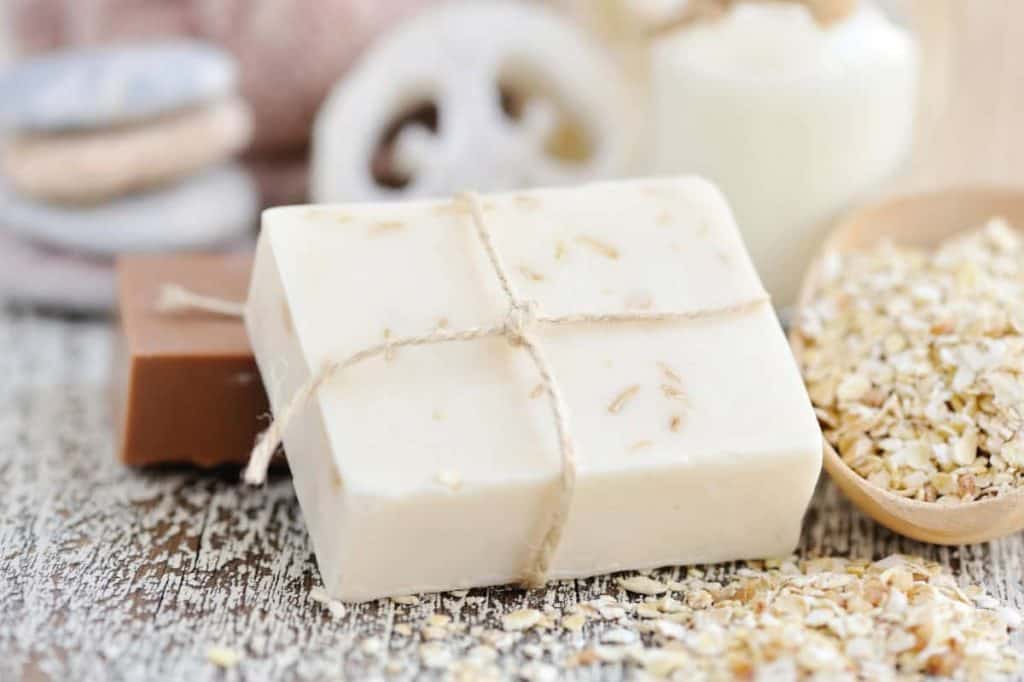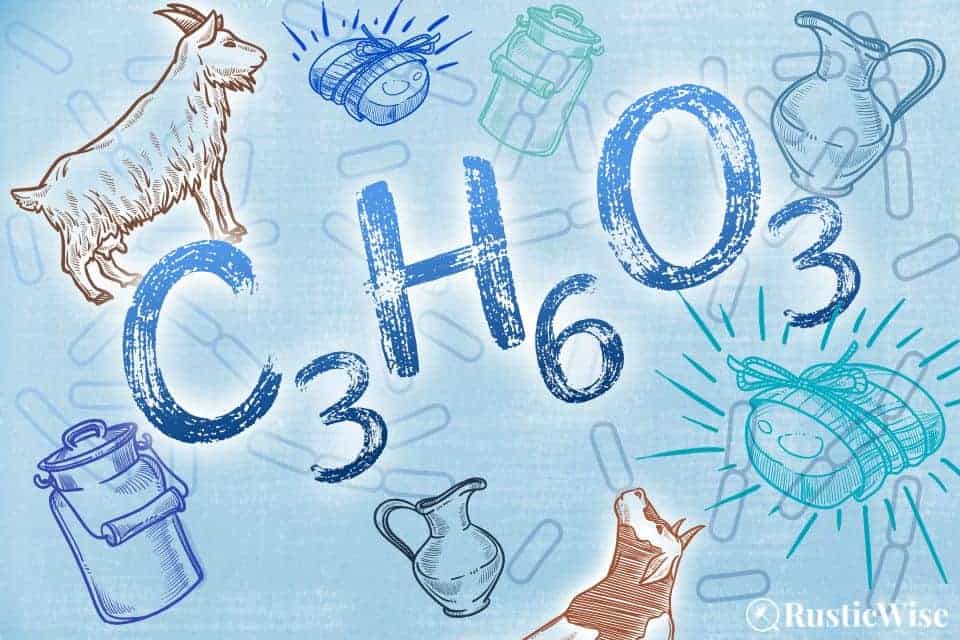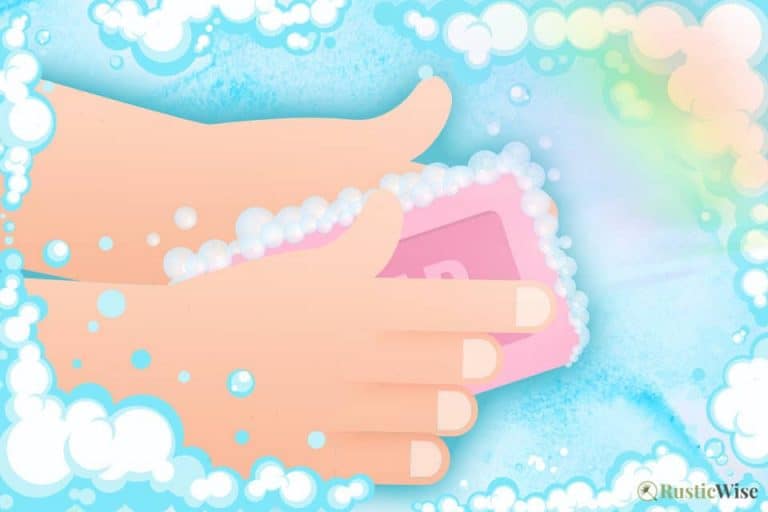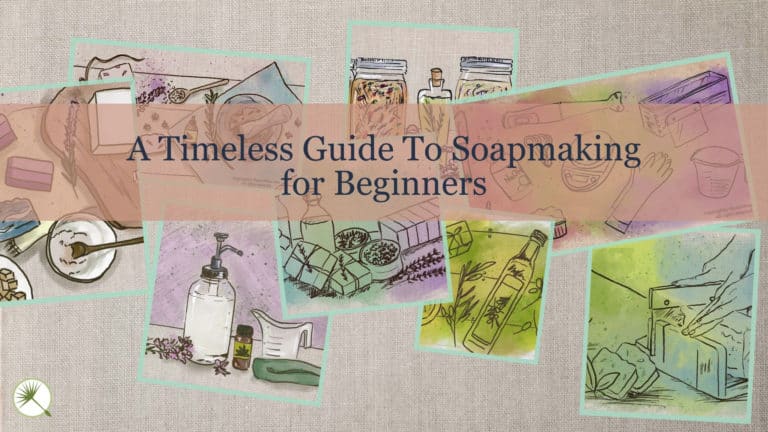Sodium Lactate and Lactic Acid in Soap: Reap the Benefits in DIY Soap
In skincare, alpha-hydroxy acids (AHAs) are all the rage for their skin rejuvenating effects. Lactic acid is one of the milder AHAs great for sloughing off the top dead layer of skin. An easy way to add lactic acid in soap is to add an ingredient that’s naturally rich in this acid, such as goat’s milk.
Sodium lactate, on the other hand, is the sodium salt of natural lactic acid made by fermenting sugar, or other plant-based carbohydrates. It’s used in cold process soap making to produce a harder bar of soap, and make the unmolding process easier.
Since lactic acid in soap and sodium lactate are really two sides of the same coin, I thought we should delve into the topic. We’ll take a closer look at the key differences between lactic acid and sodium lactate, benefits of each, plus how to use them in your batch of homemade soap.
What is lactic acid?
Lactic acid belongs to the carboxylic acids group. It’s naturally found in the juices of plants, in soil, as well as in the blood and muscles of people and animals. Lactic acid comprises a large component of fermented foods, including some cheeses, sour milk, and yogurt.¹
Today, they produce lactic acid synthetically through the fermentation of carbohydrates. A bacterium called Lactobacillus feeds on a variety of plant-based sugars (such as corn or beets) which then converts carbohydrates such as glucose into lactic acid.
Most common are liquid solutions of lactic acid in varying strengths ranging from 22 to 85 percent.¹
Lactic acid has many commercial uses. It’s used to flavor and preserve a variety of processed foods, including soda pop, cheese, pickles, and salad dressing. It’s also used during in the production of leather and wool.
Lactic acid is also a common ingredient used in the skincare market in products such as lotions and chemical peels. It belongs to the family of alpha-hydroxy acids (AHAs) of which citric acid, glycolic acid, malic acid, and tartaric acid also belong.
What does lactic acid do in skincare products?
When used at low concentrations, manufacturers use lactic acid to adjust or lower pH levels. Skincare products are typically on the acidic side to jive with the skin’s lower pH levels (which is naturally acidic).²
Lactates act as a humectant to draw and keep moisture in the skin.
In the U.S., the Cosmetic Ingredient Review panel has found lactic acid to be safe for cosmetic and skincare products at a concentration of 10 percent or lower. The product’s pH must be 3.5 or higher. Products must clearly label the need for sun protection due to heightened skin sensitivity following use.³
A study compares the effectiveness of various alpha-hydroxy acids (citric, glycolic, hydroxybutyric, lactic, and malic acids) to evaluate, “stinging potential on sensitive skin, the ability to increase skin cell renewal, and their ability to improve moisture content and reduce lines and wrinkles over a six-week period.”⁴
Results show that both lactic and glycolic acids were more mild, yet still more effective than other AHAs at improving skin’s moisture and reducing the appearance of fine lines and wrinkles. Lactic acid took the slight edge over glycolic acid when used in greater concentration—it’s less irritating to skin.
A common misconception about lactic acid
Since lactic acid sounds remarkably similar to lactose (a sugar found in milk products), it’s not surprising that those with a lactose intolerance are wary of using lactic acid in soap. After all, you’ll find lactic acid in some fermented dairy products.
But, most synthetic forms of lactic acid derives from plant-derived compounds (including corn/cornstarch, beets, or molasses) rather than animal or milk-based compounds—good news for those with a lactose intolerance.
(Less commonly, lactic acid may be fermented using dairy products like whey. The lactic acid derived in this way generally goes back to dairy products such as ice cream, or cream cheese.)
The takeaway: Lactic acid does not contain milk protein. Even if the starter culture used during fermentation is dairy-based, the finished product does not contain milk protein. If you have a milk allergy, it should be safe to use lactic acid.⁵

Credit: Deposit Photos
How do you use lactic acid in soap?
It’s not recommended that you add pure liquid lactic acid to your batch of cold process or hot process soap. Undiluted lactic acid is harsh on skin and may cause severe skin irritation when used in high concentrations.
In cold process and hot process soap making, some soapers like to use sodium lactate (derived from lactic acid) to harden up soap bars—more on this below.
What natural ingredients contain lactic acid?
The easiest way to add lactic acid to your homemade soap is to use natural ingredients that contain high levels of lactic acid.
Examples of nourishing natural ingredients that contain lactic acid are yogurt and goat’s milk. Both additives make for a creamy, skin-loving bar of soap.
Tip: Milk and dairy products are heat sensitive. When making cold process soap, it’s best to work at cooler temperatures to avoid burning or overheating these ingredients.

Credit: 123RF.com
Lactic acid skin benefits
In the world of natural soaps made from scratch, soap bars featuring goat’s milk are coveted for their skin rejuvenating properties. Reap the benefits of lactic acid by using goat’s milk in soap.
Here are a few skin benefits of homemade goat’s milk soap:⁶
What’s sodium lactate?
You can use sodium lactate as an additive to your cold process recipe to harden bars of soap, which makes it easier to unmold. It also reduces shrinking (which commonly occurs during cure time). Plus, if you like your soap bars smoother, sodium lactate helps with this too!
Sodium lactate is the sodium salt of lactic acid. It’s produced by fermenting various plant-based sugars and is water soluble.
You’ll commonly find sodium lactate as a solution, often at 60 percent strength. The solution is pH neutral and has antimicrobial properties.⁷
The shelf life of sodium lactate is around 1–2 years if stored in a sealed container at room temperature.
How do you add sodium lactate to cold process soap?
When making a batch of cold process soap, add sodium lactate to your lye solution once it has cooled to around 120 degrees Fahrenheit (49 degrees Celsius) or lower.
A little goes a long way: use between 1 and 4 percent of the entire batch weight.⁸
Or, another way to calculate is roughly 1 teaspoon per pound of oils.
How to add sodium lactate to hot process soap
You can also add sodium lactate to your next batch of hot process soap.
You can either add towards the end of the cook, or to the cooled lye solution (just like in cold process).
New to making soap? 🧼❓
👉We have a fantastic overview on the whole soapmaking process here: read our Timeless Guide To Soapmaking.
If you would like to see our soapmaking posts organized by topic type, see our Soapmaking Collection.

References
- Britannica, Lactic acid, https://www.britannica.com/science/lactic-acid. Accessed December 2021.
- Cut to the Trace (eZine of the HSCG), 2nd Quarter 2016, Issue 1. https://www.soapguild.org/how-to/cttt/eZines/2016-2Q-CTTT.pdf. Accessed December 2021.
- Cosmetic Ingredient Review Panel, Safety Assessment of Alpha Hydroxy Acids as Used in Cosmetics (2013), http://www.cir-safety.org/sites/default/files/ahas.pdf. Accessed December 2021.
- Smith, W P. “Comparative effectiveness of alpha-hydroxy acids on skin properties.” International journal of cosmetic science vol. 18,2 (1996): 75-83. doi:10.1111/j.1467-2494.1996.tb00137.x Accessed December 2021. https://pubmed.ncbi.nlm.nih.gov/19245467/
- Ataman Chemicals, Sodium Lactate, https://www.atamanchemicals.com/sodium-lactate_u25046/. Accessed December 2021.
- Davidson, Katey (20 February 2020), “6 Surprising Benefits of Goat Milk Soap,” Healthline. Accessed December 2021.
- Soaper’s Choice, Sodium Lactate 60, https://www.soaperschoice.com/sodium-lactate-60-96407sc. Accessed December 2021.
- Wholesales Supplies Plus, Crafter’s Choice™ Sodium Lactate 60%, https://www.wholesalesuppliesplus.com/products/sodium-lactate-60-percent.aspx. Accessed December 2021.

Author: Theresa Tesolin
Theresa is co-founder of RusticWise. She helps people unleash their inner DIY spirit by encouraging them to get dirty and make or grow something from scratch.










